
Lekithos, Lecithin, Phospholipids, E322, fat-and-water soluble emulsifying substances. Its various names.
In our first two parts, we introduced you to the world of Lecithin. We saw how it is omnipresent in our everyday life, in the human body. We also saw how it is a popular food ingredient used in a variety of foodstuffs. Today we discuss about the origins of Lecithin.
But first, we would like to introduce you to Phosphatidylcholine (PC). Yet another name in the list of aliases of Lecithin. A pretty complicated one you might feel, but much like the X-Men Hero Wolverine, it is probably only grim in appearance. You will understand it if you nudge yourself a little (Phos – phat – idyl – choline). It is the most promising among all constituents of Lecithin and plays a key role in the emulsifying properties of lecithin. PC content is typically used as a good measure for Lecithin quality.

“Yeah they were all Yellow…🎵🎶"
As is the source, so also will be its produce. One of the most notable things about raw lecithin liquid is its colour, much like honey. When you see its primary sources keenly, you’ll realize what we are saying. All of the top sources of lecithin around the world are some shade of Yellow colour. Let us explore each of these sources.
• Egg Yolk: Egg yolk is the first known source of Lecithin, which is in fact named after ‘Lekithos’, the Greek work for ‘Egg yolk’. Egg based lecithin extraction is a unique process and is a commercially expensive proposition. It is popular in infant food formulations and food supplements. It is associate with several benefits such as sleep induction, brain formation and memory.
• Soybean: Soy ispresently themost popular source of commercial Lecithin due to sufficient availability at reasonable prices. It is widely applied across all industries where lecithin is used including food, health, pharmaceuticals and cosmetics. However, it is extremely crucial to distinguish well between genetically-modified (GMO) and non-genetically modified (Non-GMO) sourcing of soy and thereby its lecithin. India is a global leader of superior Non-GMO soy lecithin supplies in various forms (liquid, powder and granules).
• Sunflower: Sunflower is gaining popularity slowly and steadily. One amongst the people having issues with allergen present in Soy lecithin. Two, because Sunflower does not have a GMO variety, so there is complete assurance of its Non-GMO nature. However, it still is far behind Soy Lecithin in demand due to its high prices and low availability. Functionally, it is very much similar to Non-GMO Soy Lecithin.
• Rapeseed (Canola): Rapeseed based Lecithin is catching up to its other plant based peers. However, due to low availability and less awareness of its lecithin extraction process, the acceptability of this is yet to pick up much.
Rice bran Lecithin is also an alternative with plenty of benefits. However, it is not yet popular as a source of commercial lecithin and there is full use appropriate technology is not available for its food and industrial applications. However, we are likely to see a surge of different sources of lecithin, as we are already seeing in the demand for Sunflower based lecithin.
Many people in Europe and the Americas are regular consumers of Lecithin Granules for its several health benefits. We will explore more about this and about India’s leadership in Non-GMO Soy Lecithin in further parts of our series.
Here, we take your leave. Wish you a week of good health ahead!
~ Lecilite Ingredients
 We shall go through the diverse aspects of lecithin in our weekly blog series. Stay tuned with us at Lecilite Ingredients and check our website lecilite.comto immerse into the fascinating world of Lecithin.
We shall go through the diverse aspects of lecithin in our weekly blog series. Stay tuned with us at Lecilite Ingredients and check our website lecilite.comto immerse into the fascinating world of Lecithin.
